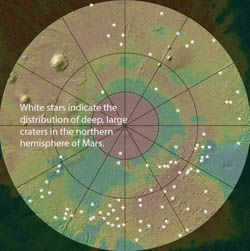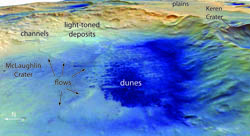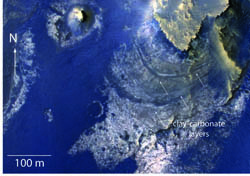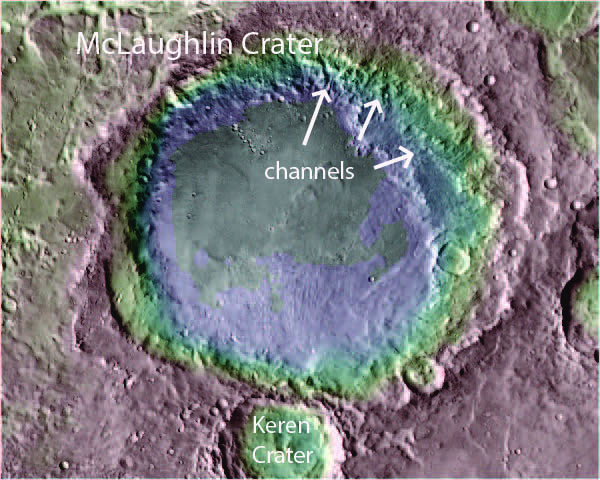Searching for evidence of life on the Red Planet
Has there ever been life on Mars? Shawn Wright, researcher and postdoctoral fellow in the Department of Geology and Geography, suggests we can only answer that question by looking in the right places. As a member of an international team of scientists, Wright recently discovered evidence for an ancient lake in one of the Red Planet’s deepest craters, leading scientists to conclude the location may have been habitable for microorganisms living deep underground.
Mars has hundreds of thousands of impact craters on its surface, providing a glimpse into the geology of the planet’s subsurface levels, explained Wright. The geologic study of Mars can provide a history of both the planet and the solar system. He cited Valles Marineris, a deep set of canyons on Mars, as an example of how subsurface formations can offer information about the past.
“Sulfates were found at the bottom of Valles Marineris. The presence of sulfates indicates there was once water present – most likely groundwater came out of the side of the canyon, dripped down into the canyon, evaporated and left sulfur,” Wright said. “Based on this information, we decided we would look at over 100 of the deepest, largest craters on Mars for further evidence of groundwater, and five locations stood out. McLaughlin Crater jumped out at us due to several features.”
McLaughlin Crater is approximately 92 kilometers wide and 2 kilometers deep, and one of the first things scientists noticed about the crater is a pattern of channels on the interior walls on the eastern side. All of the channels suddenly stop at an elevation located approximately 500 meters above the crater floor. Wright and the team of scientists believe this level was the surface of an ancient lake, and the channels were formed as groundwater seeped out the walls of the crater. The crater floor also points to evidence that water was once present as it contains clays and calcite.
“The presence of calcite is significant because calcite is a marine and/or aqueous deposit, which is rare to find on cold, dry Mars,” Wright said.
Perhaps most significant is the presence of a large deposit on the floor of McLaughlin Crater. The formation of the deposit suggests it was created from materials and debris that were thrown into the atmosphere during the formation of an adjacent, younger crater, Keren Crater.
“The rocks ejected from Keren Crater when it was formed are very far from Keren Crater’s rim, probably because of the lake that was located in the larger McLaughlin Crater. It appears the material from Keren Crater was thrown into the waters of McLaughlin Crater and it splashed and flowed to make a fairly large deposit on the floor of the larger crater,” Wright said. “Just to put it in perspective, based on studies of thousands of other crater ejecta extents and thicknesses, the ejecta, or buildup of material thrown out from the formation of Keren Crater, is 200 meters high, whereas in other craters it would only be 10 to 20 meters high.”
Wright’s research on the extraordinarily large breadth of ejecta from Keren Crater indicates the material was dispersed with the help of water and follows a pattern similar to an underwater landslide on earth. Furthermore, the scientists believe the deposits left on the floor of McLaughlin Crater have the potential to serve as preservation agents for a deep biosphere that once existed on Mars.
“Hopefully, in 30 or 40 years, we can send sample-return or man to Mars to retrieve some of these materials to see if our hypothesis is correct, if bio-signatures are preserved in this aqueous deposit,” Wright said. “We are just now really scratching the surface of Mars, and if we find evidence of past life on Mars, it could mean that other life is out there too.”
The research of McLaughlin Crater and the search for evidence of an ancient lake were made possible by technologically advanced equipment such as the Compact Reconnaissance Imaging Spectrometer for Mars, one of six scientific instruments on the Mars Reconnaissance Orbiter. A paper on the discovery was published in Nature Geoscience in January, “Groundwater activity on Mars and implications for a deep biosphere,” and can be read here.
Latest Headlines
-
04/18/2024
-
04/18/2024
-
04/18/2024
-
04/17/2024
-
04/12/2024




